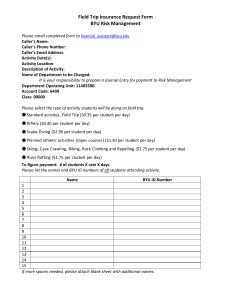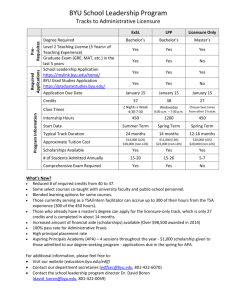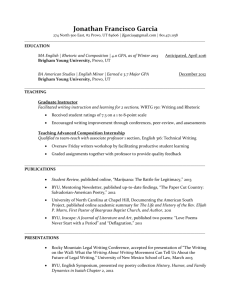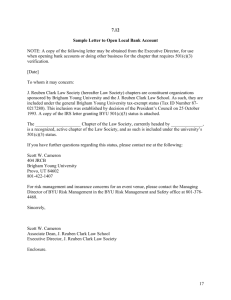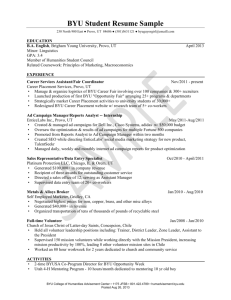BYU Campus Tour Information
advertisement
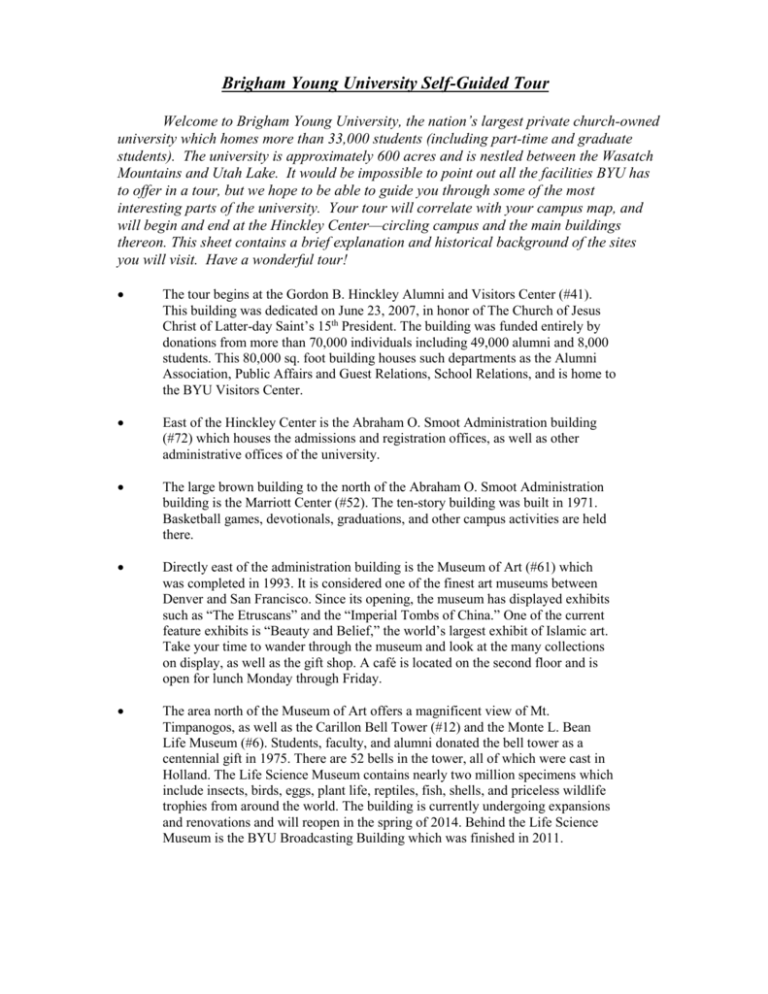
Brigham Young University Self-Guided Tour Welcome to Brigham Young University, the nation’s largest private church-owned university which homes more than 33,000 students (including part-time and graduate students). The university is approximately 600 acres and is nestled between the Wasatch Mountains and Utah Lake. It would be impossible to point out all the facilities BYU has to offer in a tour, but we hope to be able to guide you through some of the most interesting parts of the university. Your tour will correlate with your campus map, and will begin and end at the Hinckley Center—circling campus and the main buildings thereon. This sheet contains a brief explanation and historical background of the sites you will visit. Have a wonderful tour! The tour begins at the Gordon B. Hinckley Alumni and Visitors Center (#41). This building was dedicated on June 23, 2007, in honor of The Church of Jesus Christ of Latter-day Saint’s 15th President. The building was funded entirely by donations from more than 70,000 individuals including 49,000 alumni and 8,000 students. This 80,000 sq. foot building houses such departments as the Alumni Association, Public Affairs and Guest Relations, School Relations, and is home to the BYU Visitors Center. East of the Hinckley Center is the Abraham O. Smoot Administration building (#72) which houses the admissions and registration offices, as well as other administrative offices of the university. The large brown building to the north of the Abraham O. Smoot Administration building is the Marriott Center (#52). The ten-story building was built in 1971. Basketball games, devotionals, graduations, and other campus activities are held there. Directly east of the administration building is the Museum of Art (#61) which was completed in 1993. It is considered one of the finest art museums between Denver and San Francisco. Since its opening, the museum has displayed exhibits such as “The Etruscans” and the “Imperial Tombs of China.” One of the current feature exhibits is “Beauty and Belief,” the world’s largest exhibit of Islamic art. Take your time to wander through the museum and look at the many collections on display, as well as the gift shop. A café is located on the second floor and is open for lunch Monday through Friday. The area north of the Museum of Art offers a magnificent view of Mt. Timpanogos, as well as the Carillon Bell Tower (#12) and the Monte L. Bean Life Museum (#6). Students, faculty, and alumni donated the bell tower as a centennial gift in 1975. There are 52 bells in the tower, all of which were cast in Holland. The Life Science Museum contains nearly two million specimens which include insects, birds, eggs, plant life, reptiles, fish, shells, and priceless wildlife trophies from around the world. The building is currently undergoing expansions and renovations and will reopen in the spring of 2014. Behind the Life Science Museum is the BYU Broadcasting Building which was finished in 2011. Also visible from this point is one of the student housing complexes— Heritage Halls (#40). Heritage Halls is for students who prefer apartment-style living. Six students share an apartment and provide their own meals. Helaman Halls (#38), located next to Miller Park baseball fields, provides a traditional on-campus dorm experience. Two students share a room, and meals are provided at the Cannon Commons building. The Cannon Commons offers meals not only to students, but also to the community at a reasonable price. The Cannon Commons also provides other amenities which include basketball courts, laundry facilities, music practice rooms, a computer lab, a TV room, kitchenette, and tutors. About 6,000 students live on campus. Just south of the Museum of Art you will see the Franklin S. Harris Fine Arts Center (#35). You may enter this building through the north doors and spend some time browsing through the student/faculty art display in the lobby. The Fine Arts Center houses the Art and Theater departments as well as the School of Music. There are five theaters for dramatic and musical productions which are scheduled year round. After looking through the building, exit through the south doors. Directly east of the Harris Fine Arts Center you will see the J. Reuben Clark Law School (#16). The BYU Law School has a three-year program that enrolls approximately 480 students, ranking in the top 20 percent in admissions criteria nationwide. Established in 1973 and dedicated in 1975, the school admits 150 students each year. Looking east from this point you can see the famous “Y” on the mountain which overlooks our campus. It was constructed in 1906. With a height and width of 465 ft. x 168 ft., it is one of the largest school letters in the country. Until the late 1950’s freshmen were traditionally expected to whitewash the Y. It is now covered with concrete, painted by helicopter, and lit for special occasions such as Y Days, Commencement, and Homecoming. Just ahead is one of the most well liked buildings on campus, the Ernest L. Wilkinson Student Center (#87).This building includes two ballrooms, a bowling alley and game room, a food court, a post office, a computer lab, a movie theater, restaurant, salon, and the BYU Bookstore. As you head west from the Wilkinson Center, you will approach the Harold B. Lee Library (#50). This large, two-winged building is the largest library in Utah. It houses 5.2 million volumes and is recognized as a major resource for computer automation and cooperative library programs. The library’s features include the Learning Resource Center, which contains video, audio, and computer systems to aid student learning, the second largest genealogical library in the world, and a special collections library which contains collections of BYU’s rare books. The library’s two underground floors located on the north side of the building were completed in January 2000. Directly south of the library is the Herald R. Clark Building (#15). It currently houses the David M. Kennedy Center for International Studies and the Department of Study Abroad. The center is the focal point for the study and research of international affairs at BYU. It combines faculty from several departments across campus to provide a broad exposure to the various dimensions of international studies. As you head directly east from the Clark Building, you will find yourself at the Roland A. Crabtree Technology Building (#22). It houses the School of Technology, the Mechanical Engineering Department, and the Advanced Combustion Engineering Research Center (ACERC). The W. W. Clyde Building (#17) is southeast of the Clark Building. The Clyde houses the Department of Engineering, which includes civil, chemical, computer, electrical, and mechanical engineering. As you head west of the Clyde Building you will see one of our science buildings, the John A. Widstoe Building (#86), which houses the Biology and Agriculture Department – complete with cadaver labs. The building next to the Widstoe Building, connected by a covered walkway, is the Thomas L. Martin Building (#53). This building primarily contains classrooms used by campus departments. The Carl F. Eyring Science Center (#27) was re-opened in January of 1998. It houses the Food Science and Nutrition, Physics, Astronomy and Geology Departments. Originally built in 1950, it was the largest academic building in the West. There are several “user friendly” exhibits in the lobby of this building. Please feel free to further your scientific knowledge at each station. Also located in this building is the Royden G. Derrick Planetarium, which provides astronomy shows to the public every Friday evening. Just west of the Eyring Science Center is the Spencer W. Kimball Tower (#45), the tallest building on campus and in Provo at 161 ft. and 6 inches tall. It houses the College of Nursing, as well as faculty offices for the College of Family, Home and Social Sciences, which is the largest college on campus. The large building directly south of the Eyring Science Center is the Ezra Taft Benson Building (#7), completed in 1995. It is 190,000 square feet and the roof is roughly the same area as a football field. It is used mainly by the Chemistry Department for areas such as cancer and DNA research. The bottom floors houses classrooms while the upper floors are primarily research laboratories. Walking west you will see the Joseph Smith Building (#67). Named after the 1st President of The Church of Jesus Christ of Latter-day Saints, it is the center of religious studies. The original Joseph Smith Building, built in 1941 did not meet earthquake standards and had to be torn down. The current building was finished in 1991. In order to graduate from BYU, students are required to take 14 hours of religion credit (religion classes are usually 2 credit hours each). The yellow brick building west of the Joseph Smith Building is the George H. Brimhall Building (#10). The bottom floor was constructed in 1919, and the two additional floors were added in 1935. For years it served as the mechanical arts facility and also offered vocational arts, such as blacksmithing and woodworking. The building currently houses the Media and Communications Departments, and the Daily Universe, our campus newspaper. The Heber J. Grant Building (#32) is just south of the Brimhall Building. Constructed in 1925, it originally functioned as the campus library. It now serves as the University’s testing center – the largest testing center in the United Sates. Approximately 800,000 tests are administered every year from the testing center. Most of the exams taken here by the students are graded by a computer in a matter of seconds. The next stop on your tour is the Karl G. Maeser Building (#51), just west of the Grant Building. Karl G. Maeser’s statue stands at the east entrance. Maeser was a German scholar who joined The Church of Jesus Christ of Latter-day Saints and migrated to Utah. Brigham Young asked him to be the principal of Brigham Young Academy in 1876. At that time there were only twenty-nine students. Brigham Young Academy became Brigham Young University in 1903. The building, located on the area once known as Temple Hill, was constructed in 1911 and was the first building on upper campus. It was renovated in 1985 and is now the home of BYU’s Honors and General Education programs. The university used the old academy building (the tall red-roofed building located on 500 N. University Avenue) until the mid-1970s. The old academy building is currently used as the Provo City Library. As you look north you will see our next building, the Former President’s Home (#31). The President’s Home was originally the home of the university’s presidents from 1928 until 1989. President Jeffrey R. Holland was the last BYU president to live there. Since his term, President Rex E Lee, President Merrill J. Bateman, and the current president, Cecil O. Samuelson, have chosen to live in their own homes in Provo. Until recently it had served as the Visitors Center, but currently is home to the office of Graduate Studies. As you walk north, the next building on your right is the David O. McKay Building (#56), which is named after the ninth president of the LDS Church and a lifelong educator. The School of Education is located in this building and includes Educational Leadership, Psychology and Instructional Sciences, as well as Elementary and Secondary Education. If you follow the road north to the edge of the hill, you will see the physical education facilities to your left (west). The closest building on the right is the Stephen L. Richards Building (#65), which contains five gymnasiums, 15 racquetball courts, three Olympic-sized swimming pools, and nine dance studios. The departments of Dance, Health Sciences, and Exercise Sciences are located here. South of the Richards Building is the George Albert Smith Fieldhouse (#70). It contains an indoor track, locker and weight rooms, handball and racquetball courts, sports medicine facilities, and a gymnasium where the men’s and women’s volleyball teams play. Facing the Fieldhouse is the Student Athlete Building (#74). The main floor houses the Sports Medicine Departments, the football locker and weight rooms. The second and third floors house the Student Athlete Center, men’s and women’s athletic offices, and football offices. The highlight of the building is Legacy Hall. It is the BYU athletics museum, housing a hall-of-fame and other memorabilia. A delightful restaurant, Legend’s Grill, is also located on the main floor. The building farthest west is the Indoor Practice Facility (#42). It is used by all of the teams that practice outdoors and by the university for intramural sports and other activities. The building north of the Kimball Tower is the Joseph F. Smith Building (#68). It houses the College of Humanities, including the Humanities Research Center, the Center for Language Studies and the university’s language departments. BYU offers 88 different language classes and has the largest foreign language department in the nation. On-campus housing in the foreign language complex is available for students who wish to learn or maintain foreign language skills. Units from the College of Family, Home of Social Sciences are also housed in the building, such as the School of Family Life, the Family Studies Center, Women’s Research Center and child and family study labs. The building directly north of the Joseph F. Smith Building is the James E. Talmage Building (#77), which houses our Mathematics, Computer Science, Animation and Statistics departments. It was in the basement of this building that the world’s first Word Processor, WordPerfect, was developed. Keep heading north and you’ll see the Jesse Knight Building (#47). The Student Writing Center, Art Education, History and the University Police are located in this building. Across the street is the last stop on our tour, the N. Eldon Tanner Building (#78). This modern, seven-story structure was the first building financed entirely through private contributions and is home to the Business Administration and Accounting programs, as well as the Marriott School of Management. As you continue walking north you will again come to the Hinckley Center. We hope that you have enjoyed your visit to campus and invite you to spend some time becoming more familiar with any area that may have interested you. If we can be of any further assistance, please call (801)422-4678, Monday – Friday, 8:00 a.m. – 5:00 p.m. Guided tours are offered on the hour, Monday – Friday 9:00 a.m. – 4:00 p.m. Reservations can be made online at pagr.byu.edu or by calling the number above. We hope that you will visit BYU again.

